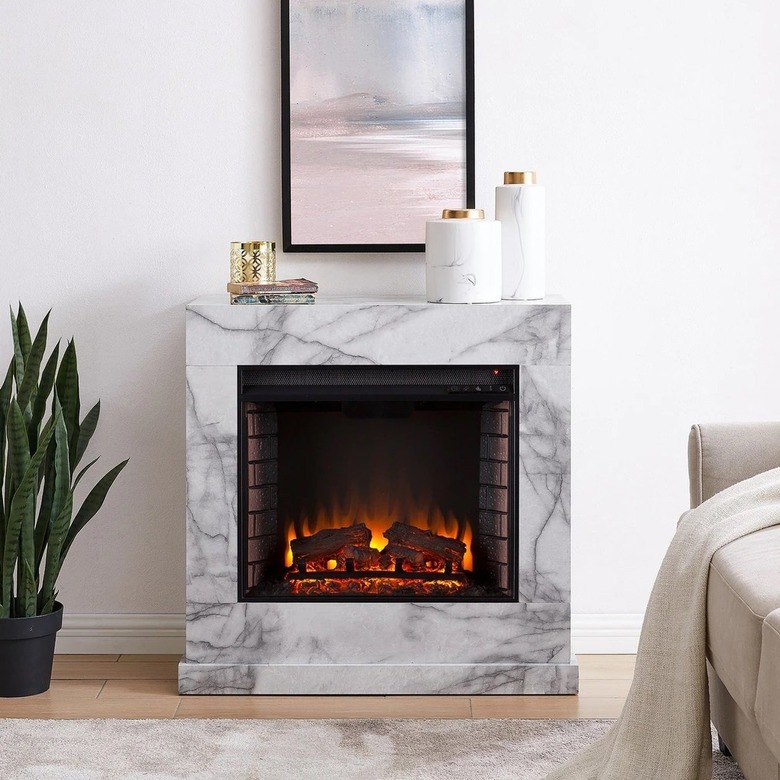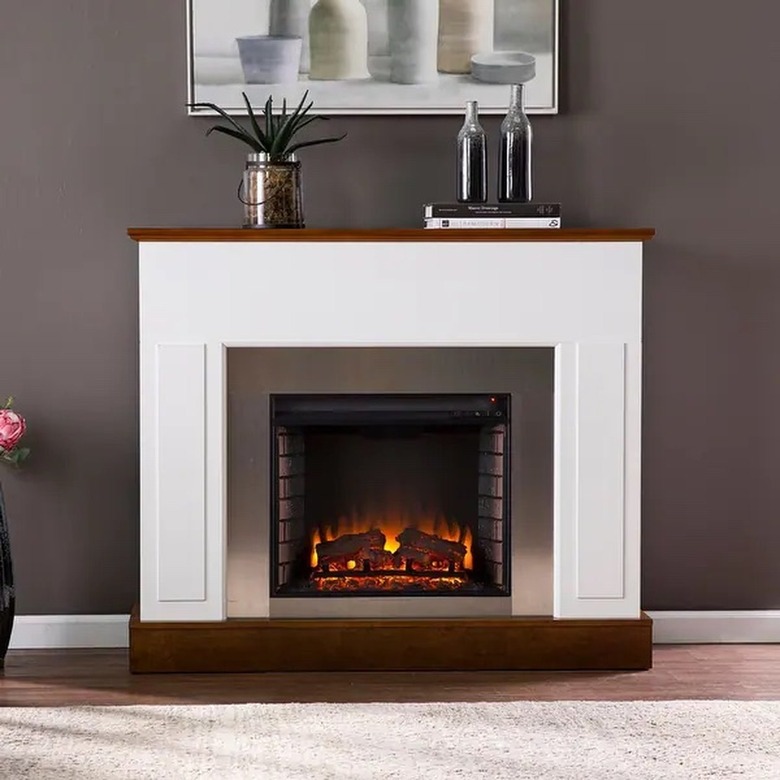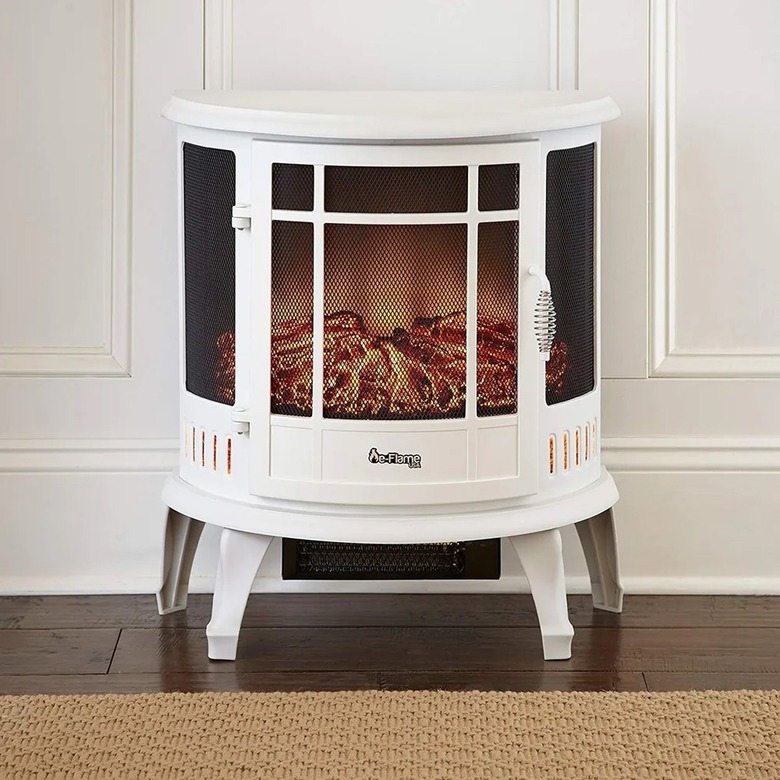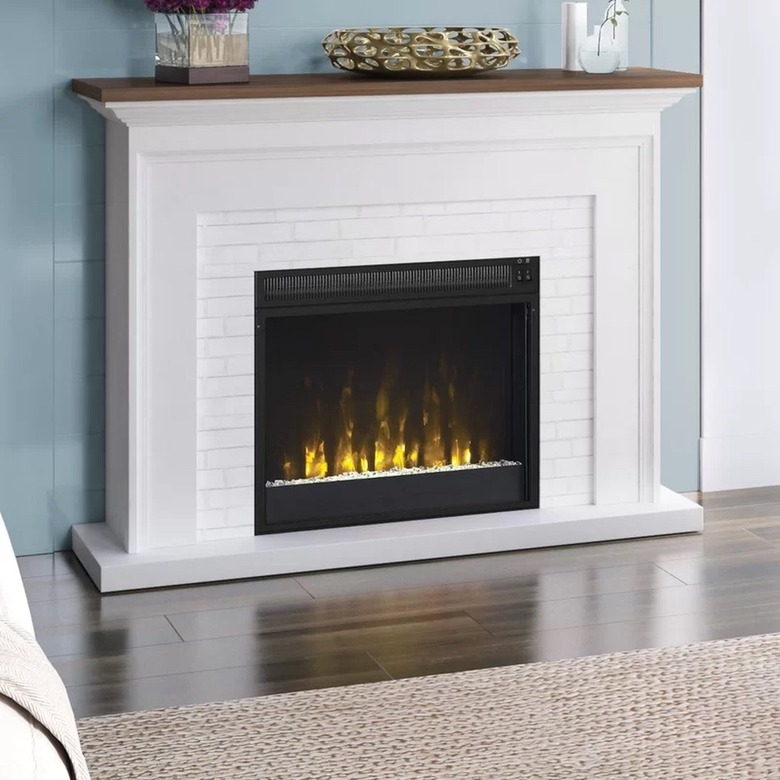The Complete Guide To Portable Electric Fireplaces
We may receive a commission on purchases made from links.
If your home has every charming feature you love except a fireplace, adding an electric fireplace can solve your problem. Adding an electric fireplace is easier and much less expensive than adding a wood or gas fireplace, both of which typically require a chimney or some other type of ventilation. You can also install an electric fireplace almost anywhere you want, including in the bathroom, a home office, or even inside a defunct wood-burning fireplace in the living room.
What Is an Electric Fireplace?
What Is an Electric Fireplace?
Whether simple and rustic in appearance or completely modern, a freestanding electric fireplace is basically a space heater with a built-in light show. Although you can purchase one without it to save a few dollars, most electric fireplaces include a space heater to warm the room as a traditional fireplace would. You can then turn on the "flames" to enjoy a traditional fireplace aesthetic or run the heater by itself to warm the space.
The reverse is also true. On a warm summer night, you can choose to run the lights on the fireplace alone and enjoy them without the heat. The "flame" produced by an electric fireplace isn't really a flame at all. Instead, these fireplaces use LED lights reflected off a series of mirrors to give the unit a flame effect. Some portable fireplace models limit themselves to yellow and red lights to imitate genuine flames. Others allow you to pick your desired color of LED flames, letting you choose from a wide variety of fun options.
Installation Needs and Concerns
Installation Needs and Concerns
Because they don't actually burn or combust anything, electric fireplaces don't require ventilation of any kind like wood and most gas fireplaces do. You can install an electric fireplace almost anywhere, and many models come ready to go right out of the box. You simply set the fireplace where you want it and plug it into the closest electrical outlet. That outlet should, however, be on its own dedicated circuit (an electrical circuit that serves only one outlet or appliance).
Some work as an electric fireplace insert in an existing gas or wood-burning fireplace that's no longer in use. Others function as wall-mounted electric fireplaces or they fit within an inset wall alcove. In instances like these, you may need to get creative about where you run the power cord. If necessary, an electrician can install an outlet for you to prevent running the power cord far.
Once you know how you intend to supply electricity to your unit, there are very few other location concerns. You can put your new electric fireplace wherever you want, including on your bedroom or bathroom wall. Some models are even rated to serve as an outdoor fireplace.
How Will It Affect an Electric Bill?
How Will It Affect an Electric Bill?
Many electric space heaters tout their energy efficiency and low operating cost, but if you've ever used one, you know better. These things can really make your electric meter spin at dizzying speeds, so be careful about what you buy. The most energy-efficient units will bear the Energy Star logo. The goal is to find a unit that creates as many Btu (British Thermal Unit, or a measurement of heat output) as possible with the lowest wattage.
On average, an electric fireplace will use between 1 kWh (kilowatt-hour) and 1.5 kWh every hour it runs. Electricity prices fluctuate, but this translates to a cost of about 10 cents to over 23 cents per hour. Many electric fireplaces are high-wattage units that can cost significantly more to run, however, so compare energy ratings carefully when shopping for an electric fireplace.
Your costs will run higher if you're heating a poorly insulated space or one that is too large. Many electric fireplaces can adequately heat 400 to 500 square feet, but heftier units can heat a room of 800 to 1,000 square feet.
The good news is that LED lights use very little electricity to operate. If you opt for the light show and leave the heater part of your fireplace off, you likely won't notice much of a bump in your electric bill.
Why Go Electric?
Why Go Electric?
When shopping for fireplaces, it quickly becomes apparent that electric isn't your only option. Gas and gel fireplaces are also popular alternatives you may want to consider. These fuels do have disadvantages over electricity, however.
1. They Can Run for a Long Time
As long as the power is on, the fireplace will run. Gel fireplaces, however, use gel canisters that burn for only about three hours. This is nice for an evening of watching TV, but you'll need to keep tending to your fireplace if you want to spend a rainy day curled up all day with a book.
2. Electric Fireplaces Don't Need Ventilation
Like an electric fireplace, gel fireplaces require no ventilation. Most gas fireplaces do, whether they run on natural gas or propane. There are some ventless gas models, but they must be paired with a carbon monoxide detector and aren't always safe. In fact, there is enough dispute over their safety that Massachusetts and California have outlawed them.
3. Safer for Kids and Pets
Note too that gas and gel fireplaces use real flames. This can create a fire hazard, and they may not be safe for children and pets. Electric fireplaces can look quite real, but you need not worry about burns or out-of-control flames.
Features to Look For
Features to Look For
While you don't technically need a lot of bells and whistles, electric fireplaces come with some optional features that will give the unit more functionality. First and foremost is the remote control. Many fireplaces come with a remote that lets you control both the amount of heat and the flame's appearance.
Some units come with sleep timers, which is a nice feature. Do you want to fall asleep at night next to your fireplace? You can set the sleep times for an automatic shutoff so it doesn't run all night. Some also have a timer so they can turn themselves on and off, allowing you to come home to a cozy fire that turns off before bedtime.
Other fireplaces come with more impractical but super-fun features. Many, for instance, let you change the color of the flames and others have an adjustable flame. Technically, you don't need to turn your fire purple or green, but it's really fun to have the ability to do so.
Smart fireplaces accept voice commands and allow you to control them through your smartphone. Others have built-in Bluetooth speakers to accommodate your favorite playlist. Do you miss that crackling sound that only a wood-burning fireplace offers? Several electric fireplace models will play the sound for you so you don't miss a thing except the smoke in your eyes.
And if you're in a small space, there are also tabletop portable fireplaces or even ones built into a tv stand — perfect for the studio dweller who wants the ambiance of a fireplace but doesn't want to sacrifice the space.
Electric Fireplace Costs
Electric Fireplace Costs
As is true with most appliances, the amount you spend on an electric fireplace will vary depending on what you want. On average, an electric fireplace costs between $400 and $850, including installation. The cost of the fireplace itself can range from $100 to $2,100 depending on what features the unit has.
The price of the fireplace will increase along with its size, features, and the amount of heat it can generate. The more realistic flame effect it has, the higher the price goes. More complex installations can also push prices upward.
Electric Fireplace Pros
Electric Fireplace Pros
Electric fireplaces offer several benefits. Once you've turned on your electric fireplace, you're finished. You don't need to keep lugging heavy logs to the fire to feed it, which also means you don't have to find a place to season and store firewood. Additionally, electric fireplaces are very easy to maintain. You can just run a dust rag over them when you clean the rest of your home. You also don't need to worry about sweeping up ashes after a fire.
Electric fireplaces are also very safe when properly installed. You don't need to worry about stray embers, smoke, or soot coming into the room or aggravating allergies. Since nothing actually combusts in an electric fireplace, you don't have to worry about carbon monoxide poisoning either.
A plethora of style options are also beneficial, letting you choose a fireplace that matches your taste and home decor. A large stone fireplace may not look good in a sleek, modern space and vice versa. Electric fireplaces are available in a wide variety of styles to fit in anywhere you want them.
Electric Fireplace Cons
Electric Fireplace Cons
While an electric fireplace can imitate the crackling sound of a fire if you wish, it's never going to provide the earthy smell of a genuine wood fire. If you're relying on the fireplace for heat, you may find yourself disappointed if you don't get a large enough unit.
You may also be disappointed with the look of the fireplace flames if you go with the least expensive model. It probably doesn't matter much if you turn your flames green, but a low-end fireplace may not be able to create realistic-looking flames, which can bother some. Electric fireplaces also go out when your power goes out, so you can't count on them for warmth when the heat is out like you can with a wood or gas fireplace.
Note too that an electric fireplace isn't likely to add any value to your home. The expense of adding a built-in fireplace with a chimney is higher, but it can also increase the value of your home by 6 to 8 percent. A portable electric fireplace just won't do that. Depending on how you've installed it, however, you can easily take it with you when you move.





